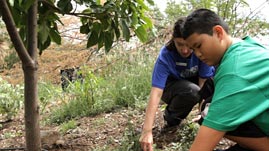Teachers' Domain - Digital Media for the Classroom and Professional Development
User: Preview

Source: Hawai'i Nature Center
In this video from the Hawai‘i Nature Center, Hawaiians talk about the state of wetlands in Hawai‘i and the important functions they serve. According to a University of Hawai‘i graduate student, wetlands support lo‘i (taro patches) and i‘a (fish), protect the land from flooding, and preserve both freshwater and ocean quality. A field crew supervisor describes a volunteer cleanup effort that helped remove garbage and invasive plants from wetlands and control erosion. Lastly, a middle school student explains that wetlands provide habitat for animals, protect against tsunamis, and combat climate change by absorbing carbon dioxide.
Vocabulary:
For Hawai‘i and other Pacific islands, the first line of defense against the ocean is wetlands. Wetlands are shallow bodies of water. They may be permanent or come and go. Wetlands on Pacific islands take a variety of forms: rivers, streams, lakes, swamps, marshes, mangroves, sea grass beds, and coral reefs. They may contain fresh water, salt water, or a mixture of both, and are home to lots of different life forms.
Wetlands serve several important functions. They protect the land from storm waves and provide areas for flood water to collect. This slows seawater or stops it from reaching further inland, where it might damage property. Wetlands are nurseries for the next generation of fish and other marine life. They help keep surface water clean by trapping sediment and pollutants, and they provide water for food crops and other plant life.
Natural threats and human activities can harm Pacific Island wetlands. The Hawaiian island of O‘ahu has lost about 70 percent of its wetlands. (This is only slightly worse than the 60 percent average loss around the world.) Warming air temperatures cause surface water in wetlands to evaporate more quickly. This also reduces water quality. The main human threats to island wetlands come from commercial activities such as land development, farming, overfishing, and coral reef mining. As a result of poor management, many wetlands have disappeared, leaving the islands and their inhabitants vulnerable to storms, sea-level rise, or droughts.
As wetlands continue to disappear, the islanders who depend on them for food or income from tourism will suffer even more. But with improved wetland management practices, Pacific islands will be better able to adapt to the impacts of climate change.
Here is a suggested way to engage students with this video and with activities related to this topic.
Class activity: Use the Just Passing Through—Learning Activity (PDF) to demonstrate how soils, like those found in wetlands, can filter and clean water. You can adapt and simplify the activity as needed to meet the needs of your students.
 Loading Standards
Loading Standards